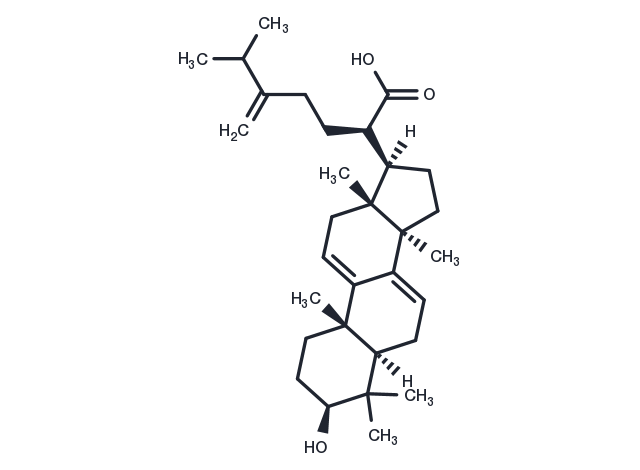Powder: -20°C for 3 years | In solvent: -80°C for 1 year


Dehydrotrametenolic acid (Dehydroeburicoic acid) induces necrotic cell death that involves Ca(2+) overload, mitochondrial dysfunction, and calpain activation in human glioblastomas.

| Pack Size | Availability | Price/USD | Quantity |
|---|---|---|---|
| 1 mg | Inquiry | $ 215.00 |




| Description | Dehydrotrametenolic acid (Dehydroeburicoic acid) induces necrotic cell death that involves Ca(2+) overload, mitochondrial dysfunction, and calpain activation in human glioblastomas. |
| In vitro | 3-(4,5-Dimethyl-thiazol-2-yl)-2,5-diphenyltetrazolium bromide and lactate dehydrogenase release assays indicated that Dehydroeburicoic acid inhibited the proliferation of the human glioblastoma cell U87MG. In addition, Annexin V and propidium iodide staining showed that Dehydroeburicoic acid treatment led to a rapid increase of glioblastomas in the necrotic/late apoptotic fraction, whereas cell cycle analysis revealed that Dehydroeburicoic acid failed to significantly enhance the population of U87MG cells in the hypodiploid (sub-G1) fraction. Using electron microscopy, we found that Dehydroeburicoic acid induced significant cell enlargements, massive cytoplasmic vacuolization, and loss of mitochondrial membrane integrity. Dehydroeburicoic acid treatment triggered an intracellular Ca(2+) increase, and Dehydroeburicoic acid-induced cell death was significantly attenuated by BAPTA-AM but not ethylenediaminetetraacetic acid or ethylene glycol tetraacetic acid. Dehydroeburicoic acid instigated a reduction of both mitochondrial transmembrane potential and intracellular ATP level. Moreover, Dehydroeburicoic acid induced proteolysis of alpha-spectrin by calpain, and Dehydroeburicoic acid cytotoxicity in U87MG cells was caspase-independent but was effectively blocked by calpain inhibitor. Interestingly, Dehydroeburicoic acid also caused autophagic response that was prevented by calpain inhibitor. |
| Source |
| Synonyms | Dehydroeburicoic acid |
| Molecular Weight | 468.71 |
| Formula | C31H48O3 |
| CAS No. | 6879-05-6 |
Powder: -20°C for 3 years | In solvent: -80°C for 1 year
DMSO: 10 mM
You can also refer to dose conversion for different animals. More
bottom
Please see Inhibitor Handling Instructions for more frequently ask questions. Topics include: how to prepare stock solutions, how to store products, and cautions on cell-based assays & animal experiments, etc.
Dehydrotrametenolic acid 6879-05-6 Apoptosis Immunology/Inflammation Proteases/Proteasome TNF NOS Caspase NO Synthase Dehydroeburicoic acid Inhibitor inhibit inhibitor
